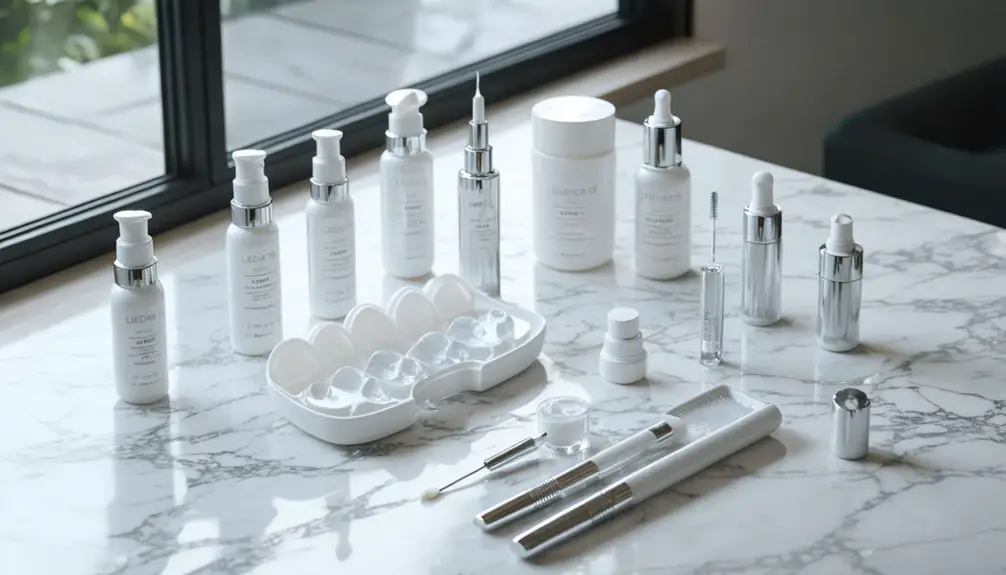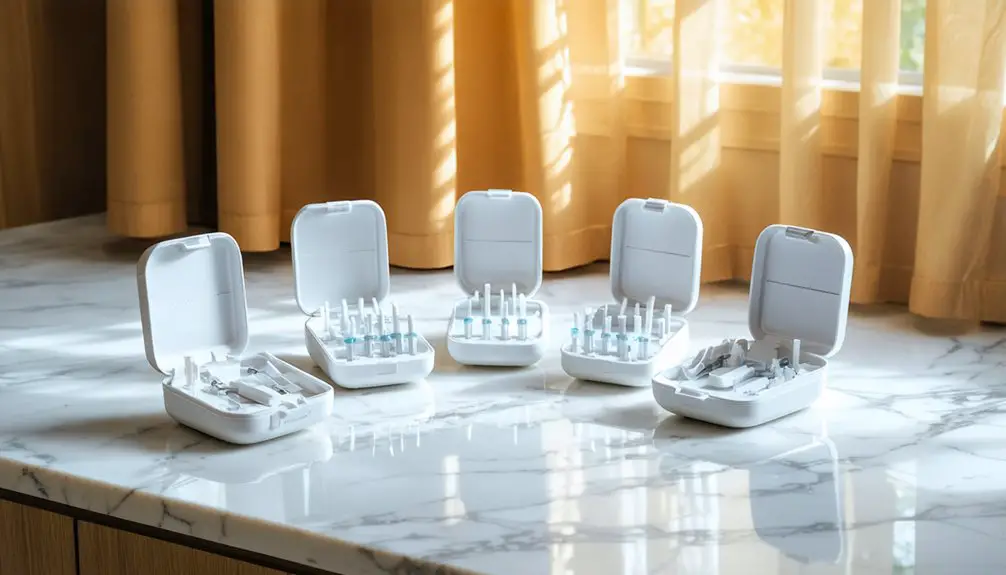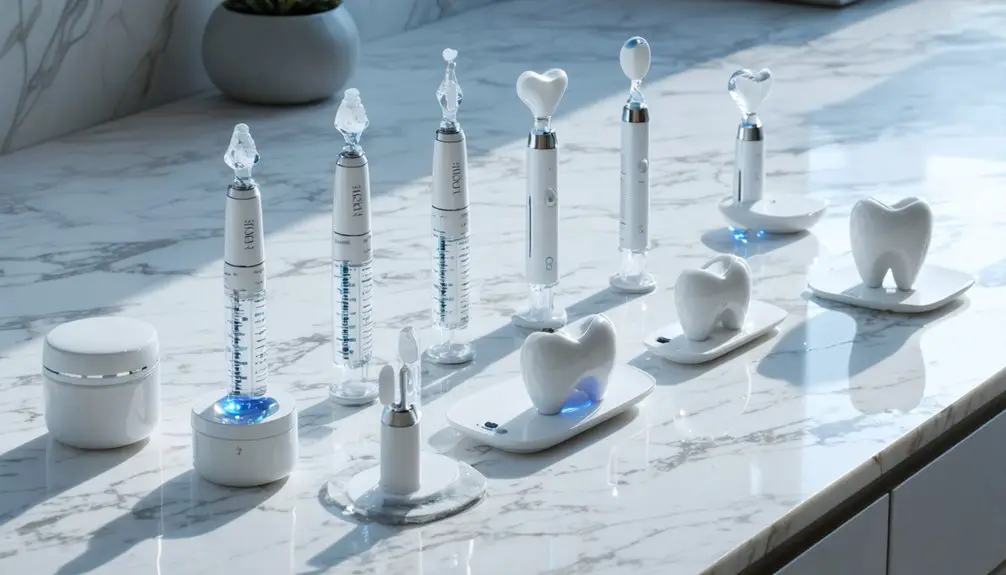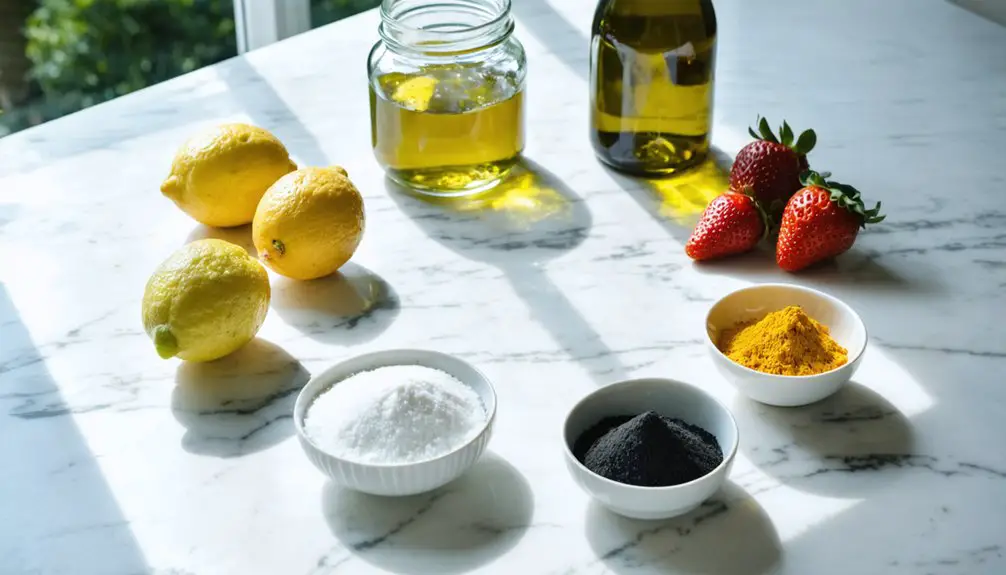You’ll find effective at-home treatments for yellow teeth through proven products like Crest 3D White Brilliance toothpaste, which removes 95% of surface stains within days. For stronger results, try Colgate Optic White ComfortFit LED system or Snow Diamond Kit with professional-grade peroxide concentrations. Whitening strips, sensitivity-safe formulas, and fast-acting pens offer varied approaches based on your needs. Understanding the science behind yellowing and proper application techniques will maximize your whitening success.
Key Takeaways
- Crest 3D White Brilliance toothpaste removes 95% of surface stains within three days using hydrogen peroxide formulation.
- Colgate Optic White ComfortFit LED and Snow Diamond Kit provide superior whitening results with minimal tooth sensitivity.
- Whitening strips deliver visible improvements within 1-2 weeks, while professional-grade treatments show results in 5-10 days.
- Sensodyne Clinical White combines effective whitening with potassium nitrate for people with sensitive teeth.
- Tray-based systems with 10-45% carbamide peroxide offer customizable treatment durations from one hour to overnight wear.
Understanding Yellow Teeth and Their Causes
While many people assume yellow teeth solely result from poor oral hygiene, the causes are actually multifaceted and complex. Tooth discoloration causes range from dietary choices like coffee, tea, and acidic foods to lifestyle factors such as smoking. Your genetics and age also play significant roles, as thinning enamel naturally reveals the yellower dentin beneath.
Enamel erosion factors include both controllable and uncontrollable elements. You’ll find that certain medications, medical treatments, and childhood exposure to excessive fluoride can affect tooth color. Insufficient brushing can significantly impact tooth color and overall dental health. Consuming highly pigmented foods like berries and tomatoes can significantly stain teeth over time.
Environmental factors and developmental conditions may contribute to discoloration as well. Understanding these various causes is essential because they’ll determine which whitening approaches might work best for your specific situation. Different types of yellowing often require different treatment strategies for best results.
How Home Teeth Whitening Products Work
When you use home teeth whitening products, you’ll encounter active bleaching agents like hydrogen peroxide and carbamide peroxide that penetrate your tooth structure to break down stain molecules.
You can apply these whitening agents through various delivery methods including strips, gels, or custom-fitted trays that hold the product against your teeth for prescribed periods. The whitening process works through oxidation reactions that target and break apart the chemical bonds of staining compounds. Using whitening products with potassium nitrate helps minimize tooth sensitivity during treatment.
Your teeth will begin showing visible results within 1-2 weeks of consistent use, and with proper maintenance, the whitening effects can last several months to a year.
Active Bleaching Agents Explained
To understand how home teeth whitening products work, you’ll need to familiarize yourself with their active bleaching agents. The most common agents are hydrogen peroxide (H₂O₂) and carbamide peroxide (CH₆N₂O₃), with concentrations ranging from 10% to 22% in home products.
When these compounds contact your teeth, they trigger oxidation processes that break down stain molecules. The bleaching agents penetrate your enamel and dentin layers within 5-15 minutes, reaching deeply embedded stains. Your enamel functions as a semipermeable membrane allowing the whitening gel to effectively permeate the tooth structure. While hydrogen peroxide provides rapid whitening effects, typically showing results in 15-30 minutes.
Through redox reactions, they release oxygen that converts colored compounds into simpler, colorless molecules. This chemical transformation alters how light reflects off your teeth, creating a whiter appearance.
The process continues working even after application, sometimes lasting up to two weeks as the peroxide remains active in your tooth structure.
Different Application Methods
Five primary application methods dominate the home teeth whitening market, each offering distinct advantages for different whitening needs.
Whitening strips provide convenient, pre-measured peroxide applications for 20-30 minutes daily, while tray systems offer customizable treatment durations from one hour to overnight. For tray-based systems, users should avoid prolonged water exposure when forming the tray to prevent warping and ensure proper fit.
You’ll find whitening pens and brushes useful for precise spot treatments, though they deliver lower concentrations of active ingredients.
LED activation devices pair with peroxide gels for 10-20 minute sessions, but research shows minimal impact on whitening effectiveness.
For daily maintenance, whitening toothpastes and rinses incorporate mild abrasives and peroxide, requiring consistent use for visible results. At-home products typically achieve a 3-6 shade improvement over several weeks of regular use.
The application duration varies greatly among these methods, from quick 60-second rinses to extended overnight treatments, allowing you to choose based on your schedule and whitening goals.
Results Timeline and Duration
Understanding how quickly teeth whitening products work helps set realistic expectations for treatment outcomes.
Intrinsic stains require extended treatment times compared to surface discoloration. You’ll notice initial subtle improvements after your first application, with more significant brightening occurring within 1-2 weeks of consistent use. Results consistency depends on your original tooth shade, stain type, and chosen product concentration. Getting a custom-fitted tray from a dental professional ensures optimal gel distribution for even whitening results.
- Professional treatments deliver fastest results, showing noticeable changes within 5-10 days
- Whitening strips typically produce visible improvements in 1-2 weeks
- LED kits and trays require 5 days to 3 weeks for ideal results
- Whitening toothpastes need 2-6 weeks for surface stain removal
While whitening effects create permanent changes in tooth color, your whitening expectations should account for potential touch-ups every 6 months to 3 years, depending on your dietary habits and exposure to staining substances.
Professional Vs Over-The-Counter Whitening Solutions
When choosing between professional and over-the-counter teeth whitening solutions, the key distinction lies in their concentration of active bleaching agents.
Professional treatments contain 25-40% hydrogen peroxide or carbamide peroxide, while OTC products only contain 3-10%. This significant difference impacts both effectiveness and safety.
Under professional supervision, you’ll receive customized treatment with higher concentrations, achieving dramatic results in a single session.
While professional whitening costs more initially, it offers better value through longer-lasting results and reduced need for retreatment. You’ll also benefit from immediate management of sensitivity and precise application using custom-fitted trays.
OTC options, though more affordable and convenient, require longer treatment periods and may lead to uneven results or sensitivity without expert oversight.
Best Whitening Strips for Stubborn Stains
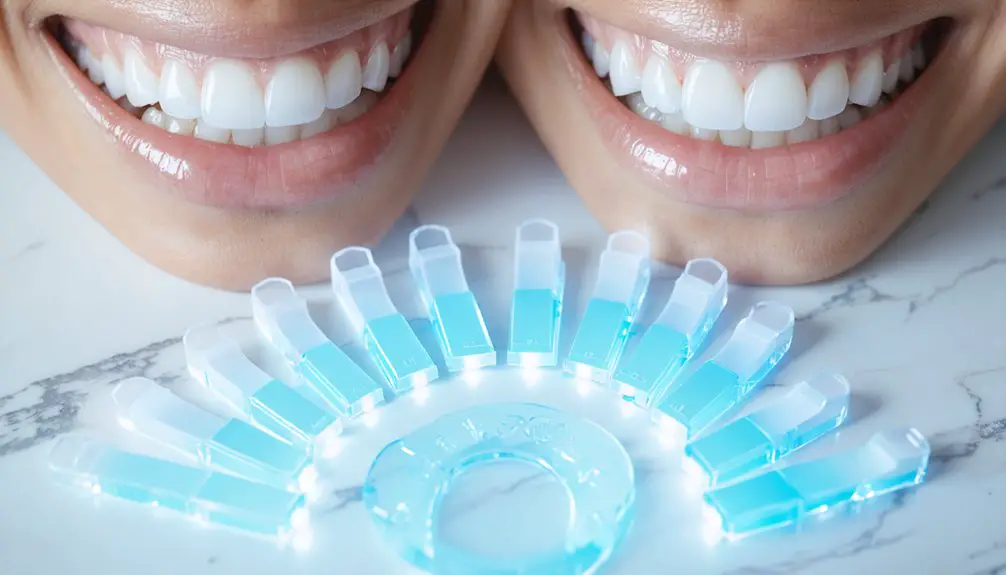
Selecting the right whitening strips for stubborn stains requires understanding both the active ingredients and their specific mechanisms of action.
Advanced formulations now utilize PAP technology as a gentler alternative to traditional peroxide-based solutions, delivering exceptional whitening effectiveness without increased sensitivity.
PAP technology brings next-generation teeth whitening, offering powerful stain removal without the tooth sensitivity associated with traditional peroxide treatments.
- You’ll achieve up to 15 years of stain removal with consistent use of Crest 3D Whitestrips over 24 days.
- Your treatment options include LED-enhanced kits, which boost results by 2.6 shades in just 19 days.
- You can target both surface and deep-set stains with PAP-based strips that penetrate your enamel.
- You’ll notice faster results with higher peroxide concentrations, though sensitivity may increase.
For ideal results, choose strips that provide full coverage of your teeth, including canines, to guarantee uniform whitening across your smile.
Top-Rated Whitening Toothpastes for Daily Use
If you’re seeking powerful whitening results, peroxide-based options like Crest 3D White Brilliance can remove up to 95% of surface stains within three days through its concentrated hydrogen peroxide formula.
For those with tooth sensitivity, Sensodyne Pronamel Gentle Whitening combines potassium nitrate with mild abrasives to provide gradual whitening while protecting sensitive teeth from discomfort.
These clinically-proven formulations deliver consistent results when used twice daily, with peroxide-based options working faster while sensitivity-safe formulas offer a more gradual approach to tooth brightening.
Best Peroxide-Based Options
Three peroxide-based whitening toothpastes lead the market for daily stain removal and tooth brightening.
For addressing teeth yellowing, Colgate Optic White Pro Series delivers maximum peroxide benefits with its 5% hydrogen peroxide formula, while Colgate Optic White Renewal and Crest 3D White provide effective alternatives with proven results.
- You’ll achieve up to 15 years of stain removal with Optic White Pro Series in just two weeks.
- Your patients can trust ADA-approved Optic White Renewal for 1-2 shade improvement within four weeks.
- You can recommend Crest 3D White for removing 95% of surface stains while protecting enamel.
- Your sensitivity-prone patients will benefit from combining whitening with cavity protection through these fluoride-enhanced formulations.
These clinical-grade options guarantee safe, consistent results when used twice daily as directed.
Gentle Sensitivity-Safe Formulas
While conventional whitening formulas can trigger tooth sensitivity, several clinically-proven toothpastes now combine gentle stain removal with protective ingredients for daily use.
Leading options like Sensodyne Clinical White and Pronamel Gentle Whitening incorporate potassium nitrate for sensitivity reduction, while strengthening enamel through targeted fluoride delivery. These gentle formulations avoid harsh peroxides and excessive abrasives that can damage tooth structure.
For those seeking natural alternatives, Tom’s of Maine Sensitive + Whitening provides chemical-free sensitivity protection.
Arm & Hammer Advance White offers controlled baking soda concentrations for safe surface stain removal.
When selecting a sensitivity-safe whitening toothpaste, look for products free from SLS and containing enamel-strengthening compounds like calcium phosphate to maintain ideal tooth integrity during the whitening process.
Most Effective Tray-Based Whitening Systems
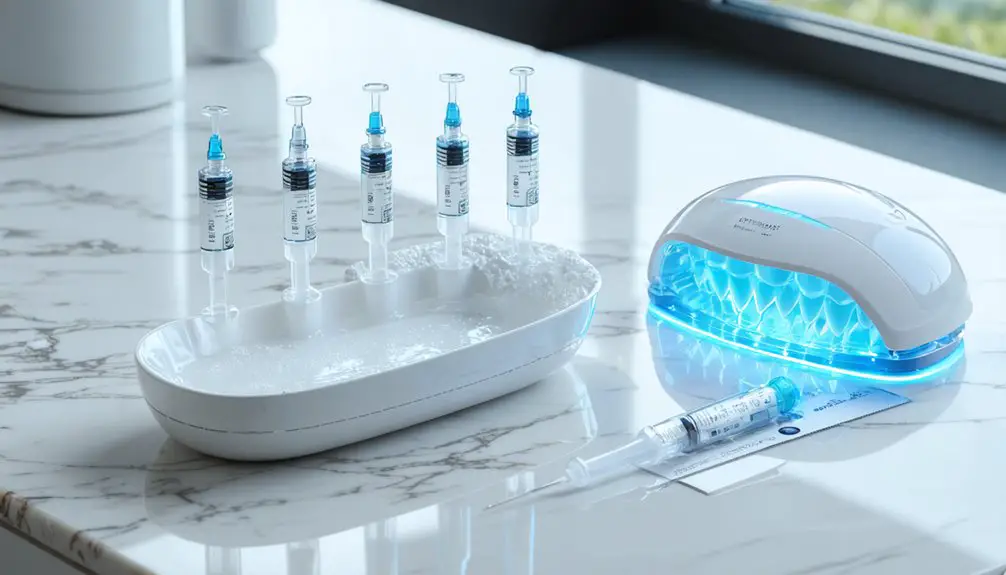
Leading tray-based whitening systems have revolutionized at-home teeth whitening through advanced peroxide formulations and LED technology integration.
Product comparisons show that Colgate Optic White ComfortFit LED and Snow Diamond Kit deliver superior user satisfaction, combining comfort with minimal sensitivity. These systems utilize carbamide peroxide concentrations ranging from 10% to 45%, allowing customized treatment approaches.
- Achieve visible results in 3-10 days with LED-enhanced trays that accelerate peroxide activation.
- Experience precise application with custom-fit options that minimize gel seepage and tissue irritation.
- Benefit from extended contact times of up to one hour daily for ideal stain removal.
- Choose from varying concentrations to balance whitening effectiveness with sensitivity management.
Professional-grade formulations like Opalescence PF offer multiple strength options while maintaining gel viscosity for controlled application and improved efficacy.
Gentle Solutions for Sensitive Teeth
If you’re seeking gentler teeth whitening options due to sensitivity, you’ll find several natural alternatives that can brighten your smile while minimizing discomfort.
Natural remedies like carefully diluted hydrogen peroxide, limited baking soda use, and coconut oil pulling can effectively remove surface stains while protecting your enamel integrity.
These methods work best when combined with sensitivity-reducing ingredients such as stannous fluoride and hydroxyapatite, which help strengthen enamel while allowing for gradual whitening progress.
Natural Whitening Alternatives
For individuals with sensitive teeth seeking whiter smiles, natural whitening alternatives offer gentle yet effective solutions without the harsh effects of traditional bleaching agents.
These holistic approaches focus on protecting enamel while gradually removing surface stains through natural remedies that won’t trigger sensitivity.
- Mix baking soda with 1% hydrogen peroxide to create a gentle whitening paste that lifts stains without compromising enamel integrity.
- Practice oil pulling with coconut oil for 15-20 minutes daily to reduce bacteria and plaque that cause yellowing.
- Incorporate crunchy fruits and vegetables into your diet to naturally cleanse teeth while maintaining a white food regimen.
- Use natural fruit acids, such as those found in strawberries, sparingly for safe bleaching properties while avoiding enamel erosion.
Desensitizing While Brightening
While pursuing a brighter smile, individuals with tooth sensitivity can now access specialized whitening solutions that incorporate desensitizing agents.
You’ll find gentle whitening options like carbamide peroxide formulations that work more gradually than hydrogen peroxide, reducing discomfort during treatment. Products combining whitening and desensitizing gels allow you to alternate between brightening and protecting your teeth.
For ideal results, choose lower-concentration products or non-peroxide alternatives featuring natural ingredients like aloe vera and coconut oil.
Custom-fitted trays help minimize gum exposure while maximizing contact with whitening agents. You can maintain results using sensitivity-focused whitening toothpastes that create protective barriers on your enamel.
Remember to follow treatment duration guidelines and incorporate desensitizing products before and after whitening sessions to fortify your teeth against potential nerve irritation.
Fast-Acting Whitening Pens and Gels
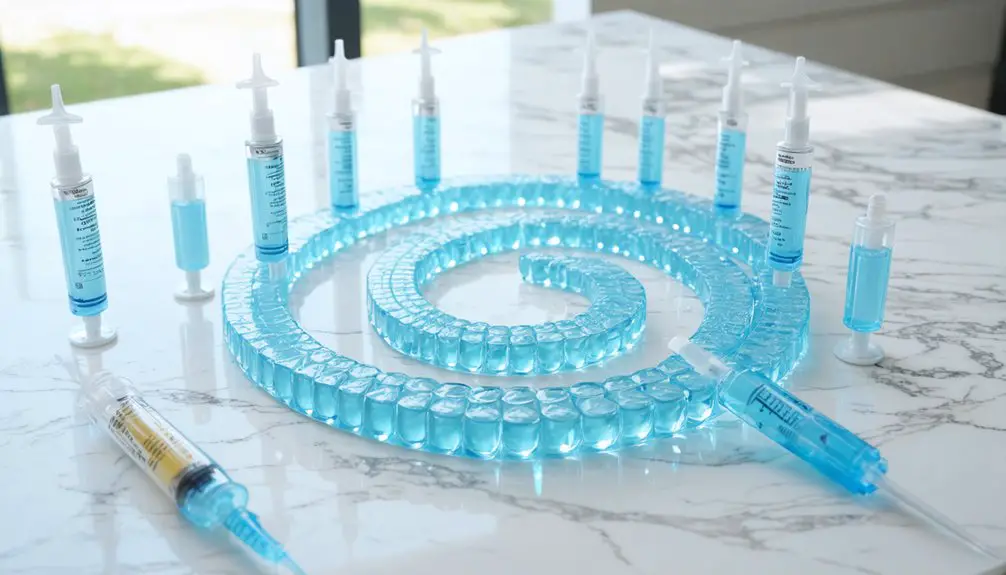
Three primary active ingredients power today’s fast-acting whitening pens and gels: hydrogen peroxide, carbamide peroxide, and PAP. These clinical-grade formulations penetrate your enamel to break down surface stains from coffee, wine, and tobacco.
Modern teeth whitening technology harnesses hydrogen peroxide, carbamide peroxide, and PAP to effectively eliminate stains from everyday beverages and tobacco use.
You’ll see ideal results by applying a thin, even layer to dry teeth, allowing 15-30 minutes of contact time before rinsing.
- Achieves 2-3 shade improvement within 1-2 weeks of consistent use
- Delivers precision application for targeting specific stained areas
- Requires minimal time investment with 15-30 minute treatment windows
- Provides portable, discreet whitening for immediate social occasions
While whitening pen benefits include affordability and convenience, these products work best for mild surface stains.
For intrinsic discoloration, you’ll need to take into account professional treatments for more dramatic results.
Long-Term Maintenance Products and Tips
Maintaining your whitening results requires a strategic combination of professional treatments and daily care protocols.
Implement monthly at-home bleaching sessions following in-office treatments to extend color persistence up to six months. Your maintenance strategies should include using toothpaste containing 3-5% hydrogen peroxide for daily stain control and custom-fitted trays for periodic touch-ups.
Essential lifestyle adjustments include limiting exposure to chromogenic substances like coffee, red wine, and tobacco. When you do consume staining agents, rinse immediately with water to minimize pigment adherence.
Choose products containing amorphous calcium phosphate, fluoride, and potassium nitrate to support enamel health during maintenance phases. For peak results, schedule professional whitening treatments every 4-6 months while maintaining consistent daily hygiene practices, including twice-daily brushing and regular flossing.
Safety Guidelines and Application Methods
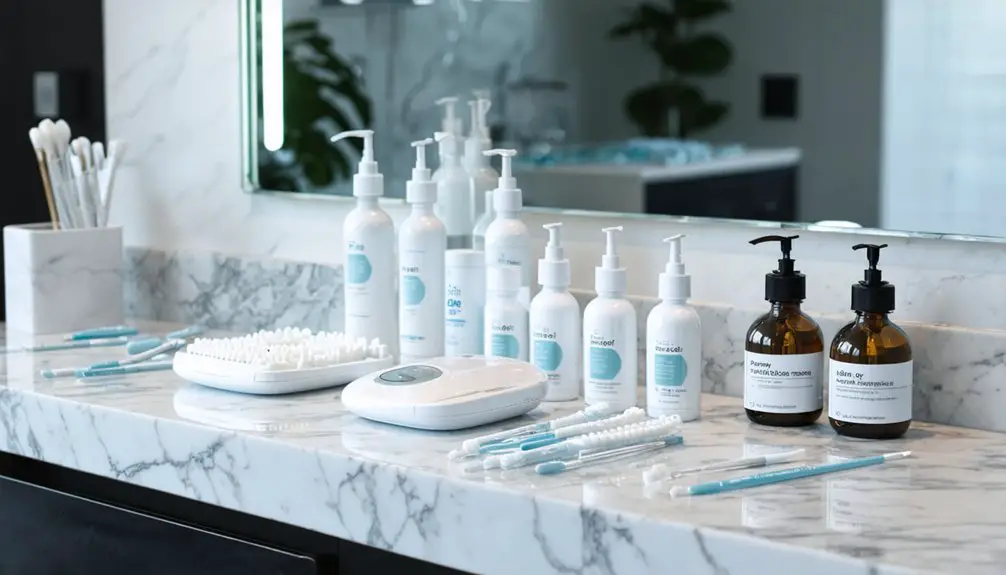
Safe and effective teeth whitening requires strict adherence to established protocols and safety guidelines. Before starting any treatment, consult your dental professional to verify your suitability and choose ADA-approved products with appropriate peroxide concentrations. Proper application techniques using custom-fitted trays help guarantee even distribution while protecting your soft tissues.
- Always perform a pre-treatment dental check to identify potential contraindications like cavities or gum disease.
- Maintain peroxide concentrations at or below 3.5% to prevent enamel damage.
- Monitor treatment duration carefully, never exceeding manufacturer’s recommended times.
- Use protective gear and maintain proper hygiene during application.
If you experience severe sensitivity or prolonged discomfort, discontinue use immediately and seek professional guidance.
Remember to store products safely and dispose of them according to instructions to protect those in your care.
Frequently Asked Questions
Can I Drink Coffee Immediately After Whitening My Teeth?
Since coffee stains can reduce whitening results by up to 60% in the first 48 hours, you shouldn’t drink coffee for at least two days post-treatment to guarantee ideal whitening maintenance.
Will Teeth Whitening Remove White Spots or Calcium Deposits?
No, teeth whitening won’t remove white spots or calcium deposits. It may temporarily make them more noticeable by increasing contrast, but they’ll typically become less visible as your teeth rehydrate over several weeks.
How Long Should I Wait to Whiten Teeth After Dental Work?
You’ll need to wait 7-14 days after fillings and two weeks after major dental work to begin whitening treatments. These whitening intervals help prevent dental sensitivity and guarantee proper restoration stability.
Do Whitening Products Work on Dental Crowns and Veneers?
No, whitening products won’t work on your crowns and veneers due to dental material compatibility. These restorations are nonporous, so they’re resistant to whitening agents and maintain their original shade despite treatment.
Should I Brush My Teeth Before or After Using Whitening Products?
Like prepping a canvas before painting, brush gently 30 minutes before whitening for ideal effectiveness. Wait 30-60 minutes after treatment to brush again, preventing teeth sensitivity and protecting your enamel.
References
- https://www.goodhousekeeping.com/health-products/g28723133/best-at-home-teeth-whitening-products/
- https://nhdentistrybeverlyhills.com/press/6-of-the-best-teeth-whitening-kits-in-the-drugstore/
- https://www.sandiegoartofdentistry.com/blog/what-is-the-best-teeth-whitening-method/
- https://www.goochlanddentistry.com/whats-the-best-teeth-whitener-for-sensitive-teeth/
- https://www.listerine.com/teeth-whitening/causes-yellow-teeth
- https://dentalstudios.com/are-yellow-teeth-a-cosmetic-or-medical-issue/
- https://www.webmd.com/oral-health/tooth-discoloration
- https://www.colgate.com.au/oral-health/adult-oral-care/ten-causes-of-yellow-teeth-and-how-to-avoid-them
- https://www.theorthodontists.com.au/blog/4-causes-for-yellow-teeth-and-how-to-avoid-them
- https://sandlakedental.com/blog/understanding-the-science-behind-teeth-whitening/
